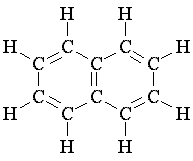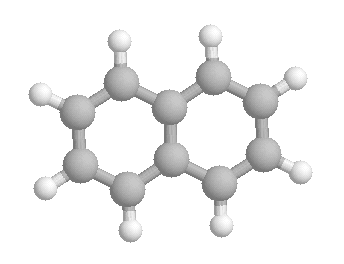 |
 |
| MadSci Network: General Biology |
What ingredients are in mothballs? Why would these ingredients keep animals from a food plot? Why would the ingredients found in ammonia, clorox, and air fresheners not keep certain animals out of a food plot? Are the ingredients in mothballs that strong?
The main ingredient in mothballs is a hydrocarbon called naphthalene. Naphthalene is called a polycyclic aromatic hydrocarbon because it has more than one ring and it is aromatic (now a description of bonding properties; a hundred years ago, a description of the fact that aromatic molecules have a distinctive odor). Here are two versions of the structure of naphthalene:
 |
 |
A caution: PAHs are carcinogenic in mammals (including humans) and so should be used sparingly and in well-ventilated areas; all food which comes in contact with them should be thoroughly washed.
Recently a species of termite from southeast Asia was found to excrete low levels of naphthalene. The termites themselves are not bothered by it, but ants (the termites' main predator) are strongly repelled by the naphthalene in the termite nests. Here's a quote from the BBC article:
The Formosan subterranean termite, Coptotermes formosanus, mixes [naphthalene] into the soil and chewed-up wood which it uses to insulate the complex of tunnels in which it lives.The fumes are thought to keep away the termite's natural enemies such as ants, poisonous fungi and nematode worms.
Scientists are mystified as to how the termites incorporate naphthalene into their nests and why they themselves are not affected by.
They carried out tests on one of the subterranean termite's greatest enemies, Solenopsis invicta, or fire ant and found the ants were immobilised at concentration levels that had no visible effect on the termites.
The original article appeared in the journal Nature.
| Dan Berger | |
| Bluffton College | |
| http://cs.bluffton.edu/~berger |
Try the links in the MadSci Library for more information on General Biology.